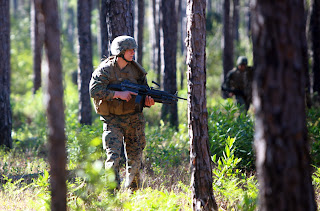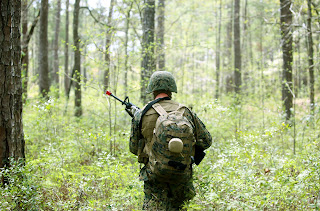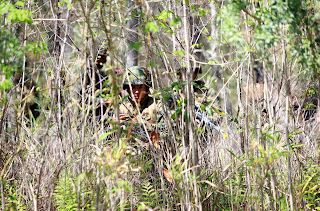Sunday, April 08, 2012
Saturday, April 07, 2012
Finally Canadians Talking Common Sense In Regards To The F-35
via the Vancouveur Sun. Read it all but the juicy part.
Way to go buddy. Cut through the nonsense of the "cabal" and get to brass tacks. Matthew Fischer! I gotta buy you a beer.
Unfortunately, sometimes ridiculously exaggerating what the auditor-general had to say about how the proposed purchase has been handled, politicians and other critics merge these two issue, using the bureaucracy's mistakes to question the need for the fifth generation F-35 itself.I ABSOLUTELY LOVE IT!
Let's live in the real world. Unless Canada decides drastically to change its defence strategy and becomes pacifist and isolationist, we will continue, as we have done for a century, to commit ourselves to military alliances and partnerships to further our national interests. To be worthy allies and partners we have to be more than peace-keepers uttering platitudes - the bulwark of the Liberal defence strategy for years.
As with the entire F-35 debate, the auditor-general's report is being discussed with no external context.
The competence and integrity of the folks at the Defence Department aside, what about the eight other partner countries in the program, and the Japanese, who have ordered 42 F-35s? Why are a bunch of Europeans signed up to an American program when the EU nations already produces several newish fighter jets of their own. Are they all idiots, too?
The multinational JSF program follows on that of the F-16, another U.S. warplane chosen by many European countries about 30 years ago. As with the F-35, the F-16 had initial teething problems but it was ultimately successful. This may explain why the F-35 European partner nations have shown far more patience with the F-35's hurdles than Canadian critics have.
As for Canada not having a competitive bidding process before deciding on the F-35, neither did its JSF partners except the U.S., which chose Lockheed Martin's X-35 over Boeing's X-32 in an early design competition. The Japanese, who are not partners, did hold a competition and concluded the JSF was better than Boeing's Super Hornet and the Eurofighter consortium's Typhoon.
There is no competition to be had if you want stealth and a networked capability because there are no other western aircraft being produced now that have this. It is that simple.
Way to go buddy. Cut through the nonsense of the "cabal" and get to brass tacks. Matthew Fischer! I gotta buy you a beer.
Friday, April 06, 2012
Four Ship...
Update: Helicopter Sea Combat Squadrons
LEESEA (thanks bud! I didn't even know these guys existed) tipped me to some information that escaped my notice. The US Navy has established Helicopter Sea Combat Squadrons. Why have I missed it? Because all I've seen them doing online is ship board replinshment ops. Well they have a much bigger mission scope. This is from HSC-22's website.
I'd like to see it pared down to a pure combat and combat search/rescue mission set but helicopters are by their very nature multi-role.
I'll take what I can get. This is the kind of stuff the Navy should be beating its chest and screaming at the moon about. Go to HSC-22's website to read more about them.
Pretty damn impressive mission set...Our Mission: To deploy helicopter detachments for Littoral Combat Ships, Amphibious Ready Groups and Combat Logistics Ships to perform Naval Special Warfare, Amphibious Search and Rescue, Theater Security Cooperation, Strike Coordination and Reconnaissance, Anti-Surface Warfare, Humanitarian Assistance and Disaster Relief and Utility missions in support of the Fleet and our National Defense.Our Vision: To be recognized as the Navy's premiere Helicopter Sea Combat Squadron by consistently accomplishing the mission and safeguarding our people, our most valuable resource.
I'd like to see it pared down to a pure combat and combat search/rescue mission set but helicopters are by their very nature multi-role.
I'll take what I can get. This is the kind of stuff the Navy should be beating its chest and screaming at the moon about. Go to HSC-22's website to read more about them.
Another Fact About The F-35 You Won't Hear On Aviation Week (or there followers)....
via Navy News Service.
All three services have units in place to begin training.
On this one subject the Commandant being an Aviator probably helps. On this he'll push like a madman to get this started...the AAV and MPC programs might lag but the training will start up before the end of this year.
Oh and check other spots to see if this is reported.
It won't be.
They'll report dubious information....like a 50 year estimated life cycle cost of the F-35...but they won't report this certified fact.
Amazing.
EGLIN AFB, Fla. (NNS) -- Navy personnel are busy preparing to teach the next generation of Sailors how to work with and fly the newest military aircraft, the F-35C Lightening II Joint Strike Fighter, as Strike Fighter Squadron 101 (VFA-101) readies for its stand-up ceremony on Eglin Air Force Base May 1.So the gang is all there.
The F-35 is a single seat, multi-role fighter aircraft with the capability to perform ground attack, reconnaissance, and air defense missions. The aircraft is in full production at the Lockheed Martin plant in Fort Worth, Texas. The F-35 is designed to eventually replace the F/A-18 Hornet and AV-8B Harrier tactical fighter aircraft and was planned with a common design, but three unique service variants, to keep development, production, and operating costs down.
"This is brand new aircraft platform from tooth to tail," said Cmdr. Scott Kartvedt, commanding officer of VFA-101. "We're not parlaying off any Navy stealth legacy programs or support systems. This will be the first new stealth and carrier-based tactical fighter aircraft since the introduction of the F/A-18 29 years ago."
The original Fighter Squadron 101 (VF-101), nicknamed the "Grim Reapers," was established May 1, 1952 and flew various models of fighter aircraft including the F-4 Phantom and F-14 Tomcat. With the retirement of the F-14, VF-101 was disestablished in 2005.
To support the new Navy version of the F-35, VFA-101 will be reestablished May 1 at a new hangar and training facility on Eglin AFB and will serve as the Fleet Replacement Squadron (FRS), training pilots and maintainers for the fleet.
The first Sailors to help stand up VFA-101 will receive 'Plank Owner' certificates for their assistance with the new aircraft, new training facilities and redesignated squadron. As per Navy tradition, plank owners are individuals who were members of the crew of a ship when that ship was placed in commission.
"I'm learning a lot and really enjoy working with other services," said Senior Chief Logistics Specialist (AW/SW) Mirtha Martinez, Material Control Department leading chief petty officer for the squadron. "I'd love to come back in five years and see the squadron fully functioning."
Marine Col. Arthur Tomassetti, vice commander of the 33rd Fighter Wing, said establishing a squadron to train and work with the F-35 aircraft has not been easy, but the leadership has taken charge and is working towards building the best facilities possible to work with this new aircraft.
"The concept was simple; establish an initial training center for pilots and maintainers for the F-35 weapon system," said Tomassetti. "Bringing that concept to reality has been and will continue to be complicated and challenging. So the first step is you start with the best people you can find, put them together, and say 'go.' Over the past two-and-one-half years, those carefully selected people have put together a strategy, developed plans, adapted to the dynamic and ever changing environment and schedule, and continued to track towards the goal of establishing a training center for F-35 pilots and maintainers."
The mechanics of the Navy F-35 will initially be taught by Lockheed Martin personnel to Navy instructors, who will then begin teaching students after completing instructor certification. Students are expected to arrive for maintenance instruction in 2015, with the first F-35s scheduled for deployment 2017-2018.
The Navy's version of the F-35, the 'C' model is distinct from the F-35A and F-35B versions with larger wing surfaces and reinforced landing gear for greater control in the demanding carrier take-off and landing environment.
Sailors in the majority of aviation rates are eligible to attend the F-35 course of instruction, including aviation ordnancemen, aviation structural mechanics, aviation machinist's mates, aviation electronics technicians, aviation electrician's mates, aviation structural mechanics and aircrew survival equipmentmen.
VFA-101 is a part of the 33rd Fighter Wing, a joint-service graduate flying and maintenance training wing responsible for F-35 A/B/C pilot and maintenance training for the Navy, Marine Corps, and the Air Force. Initially, 59 aircraft and three flying squadrons, one for each service's aircraft variant will be based at Eglin Air Force Base, Fla. The F-35 Academic Training Center serves as the schoolhouse, where wing personnel expect to train more than 2,000 maintenance students and 100 pilots each year.
All three services have units in place to begin training.
On this one subject the Commandant being an Aviator probably helps. On this he'll push like a madman to get this started...the AAV and MPC programs might lag but the training will start up before the end of this year.
Oh and check other spots to see if this is reported.
It won't be.
They'll report dubious information....like a 50 year estimated life cycle cost of the F-35...but they won't report this certified fact.
Amazing.
The Sea Wolves. Time again.
The US Navy has designated helicopter squadrons to support Special Operations Command.
Awesome. Good for them.
But its time the Navy took care of its core missions first.
Like adequate defense and attack in the littoral regions and further inland.
Fast attack aircraft are awesome weapons of war but after deploying the Riverine Units its time to give those units the support they need.
The Navy needs to bring back the Sea Wolves.
How this fabulous capability was allowed to die is beyond me but if the Navy were to procure a sufficient number of AH-1Z's...put them in Navy markings with Navy pilots and attach them to Riverine Units during wartime...and carriers during the time in between then you'd have a tremendous capability. My concept of employment might be off but the war record is undeniable...check out the website here.
Thursday, April 05, 2012
Combat Logistics Regiment 25 gets gruntified!
All photos by Pfc. Franklin E. Mercado
Visby Class Stealth Corvette.
One sixth the weight, but with three times the firepower and less than one half the price. If I was in the surface Navy I'd be sick to my stomach. The LCS is going to be outclassed by all opponents and allies.
The LCS. The Navy's version of the Stryker...better in theory than reality.
Hasty Rappel at the Jungle School...
All photos by Lance Cpl. Erik S. Brooks Jr.
| Marines with CLR-37 rappel down a 70-foot cliff at JWTC April 2. The Marines performed three controlled safety stops as part of their training. |
Subscribe to:
Posts
(
Atom
)











